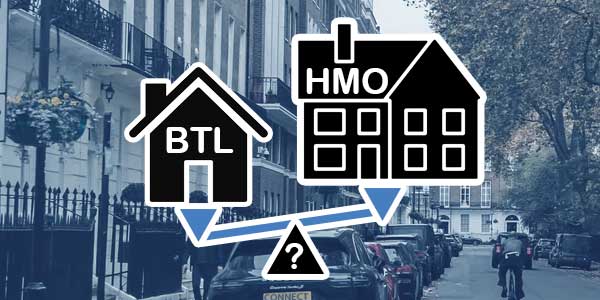HMOs, or houses in multiple occupation, are covered in this guide. These rental properties differ significantly from traditional buy-to-let investments. They typically accommodate three or more unrelated tenants who occupy separate bedrooms but share communal areas such as kitchens and living rooms. In contrast, standard buy-to-let properties are usually rented to a single family, couple, or individual.
Buy-to-let properties are popular investments across the UK and can attract a wide range of tenants. These may include working professionals, families, or individuals receiving housing benefits. However, HMOs tend to attract specific tenant groups. For example, they are often in demand near universities, appealing to student groups. They are also popular in towns with good transport links and amenities, which attract professional commuters.
Landlords should also consider potential void periods. Traditional buy-to-let properties may experience fewer void periods, while HMOs often face higher vacancy rates. Additionally, HMOs may increase maintenance costs due to shared communal areas such as kitchens, bathrooms, and living spaces. These factors should be assessed carefully when considering an HMO investment.
Read below about HMO vs Buy to Let and make your decision:
Things to consider when opting for an HMO mortgage
When comparing HMOs to standard buy-to-let properties, landlords can often collect higher monthly rental income. This is because HMOs generate separate rental payments from each tenant. Once utility bills and maintenance costs are deducted, the overall income is typically more substantial, making HMOs a profitable investment option.
Initial Setup Costs and Requirements
Setting up an HMO requires more time and financial input than traditional buy-to-let properties. However, there are several advantages. For instance, HMO properties often include furnishings, which are factored into the cost. Additionally, landlords must install locks on bedroom doors to meet UK health and safety standards, ensuring added security for tenants.
Compliance and Regulations
Although the health and safety regulations for HMOs are more stringent than for other property types, landlords who comply with these standards can find the investment highly rewarding. Shared spaces, such as kitchens, bathrooms, and living rooms, may require more frequent upkeep than traditional rentals. This is because tenants in buy-to-let properties often take better care of their homes.
Licensing and Planning Permissions
Before purchasing an HMO property, landlords must obtain the required licence. It is also essential to check whether the area has any Article 4 Directions, which may restrict property conversions. Conducting this research can help landlords make informed and profitable decisions.
Tenant Management and Void Periods
Managing an HMO involves additional responsibilities, such as checking references and creating contracts for each tenant. Landlords should also prepare for potential void periods, which are more common in areas like Bexleyheath that cater to students. Properties for student housing may face longer vacancies during the summer months, adding strain to landlords’ time and resources.
While HMOs demand more effort and compliance with regulations, they also offer significant financial rewards. Landlords can maximise their investment potential by conducting thorough research and maintaining high standards.
HMO mortgages:
Securing a mortgage for HMO properties is more complex than standard buy-to-let mortgages, and far fewer lenders offer them. These lenders’ rates and fees are typically much higher than other mortgages.
To receive the right guidance on investing in an HMO property in Kent, London or Edinburgh, talk to your experienced local mortgage broker today! If you’re searching for a Welling and Pimlico mortgage, you’ll likely need to go through a mortgage broker instead of pursuing it directly from the lender.
A qualified broker can help discover deals not advertised publicly, thus providing you with more options than if you visited the bank.
Things to consider when opting for a standard Buy-to-let mortgage
Standard Buy-to-Let Properties:
For landlords, rental investments involve fewer hours for reference checks and signing tenancy agreements. An unfurnished buy-to-let property typically experiences less wear and tear than an HMO property. Tenants are responsible for utility bills, saving money and reducing additional tasks that could consume valuable time. Despite this, standard buy-to-let properties often deliver lower returns compared to HMO rentals. However, they provide a simpler and more manageable investment option, offering landlords extra free time.
Buy-to-Let Mortgages:
Buy-to-let mortgages are widely available at competitive rates. They often have stricter criteria than standard residential mortgages but are generally simpler than HMO specialist loans.
HMO vs Buy to Let: Which is the Better Investment?
HMO vs buy to let Advantages of HMO Properties:
- Superior cash flow strategy compared to traditional Buy-to-Let properties.
- It offers the potential to replace your job more quickly if that is your objective.
- It allows you to choose between accommodating students or young professionals, but it is generally recommended to keep these groups separate.
- Flexibility to start small with properties featuring 4 bedrooms or scale up to larger properties with 10 or more bedrooms.
Planning permission may not be required in certain areas not subject to Article 4 regulations and with a limited number of bedrooms.
HMO vs buy to let disadvantages of HMO Properties:
- Increased risk and cost associated with managing HMO properties.
- Requires staying up-to-date with extensive regulations related to inspections, safety certificates, and building codes, including the installation of fire doors, fire blankets, and integrated fire safety systems for properties with three or more floors.
- HMO properties tend to experience higher tenant turnover rates, particularly among young professionals, which can make them more time-consuming to manage.
The presence of more occupants in HMO properties can lead to higher wear and tear on the property. - Planning permission is often necessary for desirable areas such as popular city centres.
- First-time HMO landlords may face higher mortgage interest rates, as most lenders prefer a minimum of 12 months of landlord experience typically gained from owning buy-to-let properties.
HMO vs buy to let advantages of Buy-to-Let (BTL) Properties:
- Easy to get started, as no prior experience is typically required to obtain a BTL mortgage.
- Provides an opportunity to gain experience in property investment through small refurbishment projects.
- Numerous managing agents are available to handle property management if you prefer not to self-manage.
- Abundance of online resources and information to assist you in setting up your first BTL property.
- BTL properties are considered a fundamental offering for mortgage brokers, representing a straightforward form of lending.
- Daily management can be hands-off once the property is rented and in good condition.
HMO vs Buy-to-Let: Choosing the Right Property Investment Strategy
When comparing HMOs and Buy-to-Let properties, there is no clear winner. The right choice depends on your strategy and preferences.
If you are new to property investment, start with a buy-to-let property. Conduct thorough research and build a reliable team, including a broker, accountant, and solicitor. This approach helps you learn about property investment, tenant management, company setup, and regulations. It also prepares you for handling challenges and successes.
An HMO can provide higher monthly income with fewer properties. However, it may not suit beginners due to its complexities. Starting with a buy-to-let property allows you to gain experience before moving to HMOs. This step-by-step method ensures better preparation and confidence.
Personal preferences also play a key role. Some investors prefer buy-to-let properties for their simpler management and family-oriented tenants. Others may find that the higher income from HMOs is worth the added responsibilities.
Your final decision depends on your goals, experience, and comfort with managing tenants. Carefully assess your situation to determine whether an HMO or buy-to-let property fits your needs best.
Thank you for reading our “HMO vs Buy to Let | Which is the Better Investment?” publication. ” Stay “Connect“-ed for more updates soon!






